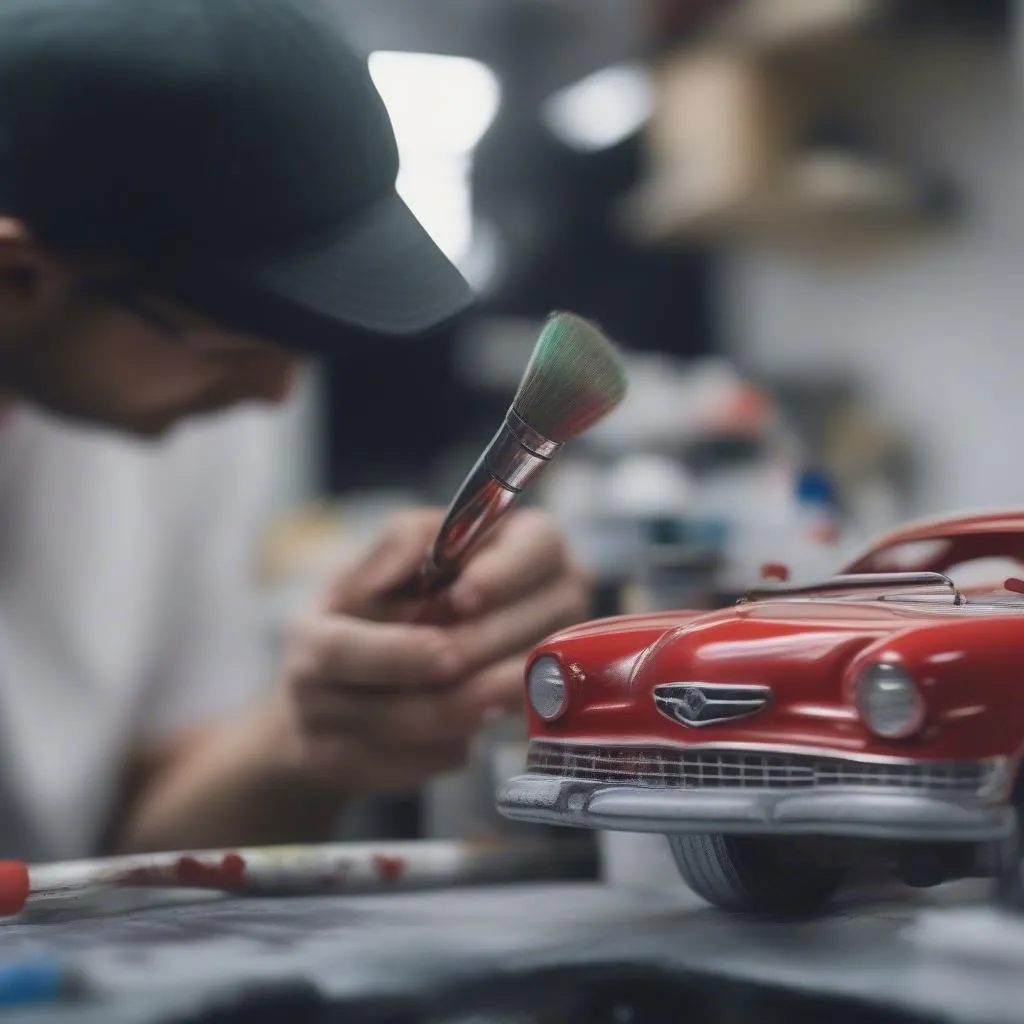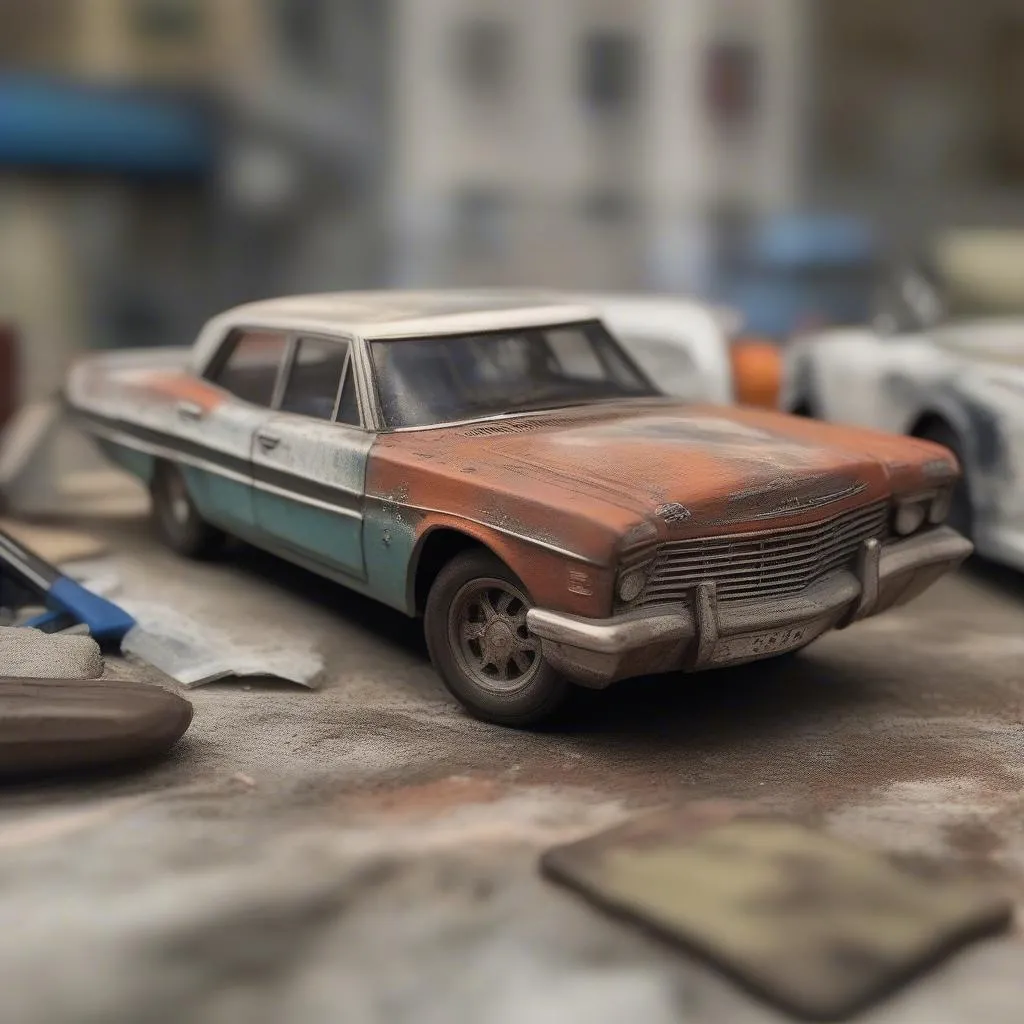Have you ever been drawn to the meticulous detail and vibrant colors of a perfectly painted model car? Maybe you’ve admired the craftsmanship of a seasoned modeler, their hands gracefully navigating the brushstrokes across the miniature canvas. The desire to bring your own miniature automotive vision to life might be simmering within you, but you’re unsure where to start. Well, fear not! This comprehensive guide will walk you through the exciting world of model car painting, equipping you with the knowledge and skills to create stunning miniature masterpieces.
The Art of Model Car Painting: A Journey of Detail
Model car painting is more than just applying paint to plastic. It’s a captivating journey that blends artistic skill with technical precision. It’s about capturing the essence of a real car, its sleek lines, intricate details, and eye-catching colors. Whether you’re a seasoned modeler or a curious beginner, understanding the significance of this meticulous process is crucial.
The “Why” Behind Painting a Model Car: More Than Just Aesthetics
Beyond the obvious visual appeal, painting a model car offers a unique opportunity to express your passion for automobiles. It allows you to customize a miniature representation of your favorite car, replicating its original paint job or even crafting your own unique design. It’s a chance to inject your personality and creativity into a project, transforming a basic kit into a personal statement.
The Technical Side: Why Accuracy Matters
From a technical perspective, the accuracy of the paint job elevates a model car to a higher level of realism. Imagine a meticulously sculpted car with flawless lines, but the paint job doesn’t capture the subtle variations of color, the depth of the metallic finishes, or the realism of weathering. The painting stage is where the model car truly comes to life, transforming a static object into a convincing representation of its real-world counterpart.
Demystifying the Process: A Step-by-Step Guide
Now that we’ve explored the significance of painting a model car, let’s dive into the process itself. Don’t worry, it’s not as daunting as it might seem. Here’s a step-by-step guide to help you navigate this creative adventure:
Step 1: Preparation is Key: Setting the Foundation for Success
Before you even think about picking up a paintbrush, proper preparation is essential. Just like a painter prepares their canvas, a modeler must ensure their miniature canvas – the model car – is ready to accept paint.
The Fundamentals of Preparation:
- Cleaning: Gently wash the model car with warm, soapy water to remove any residue from the molding process.
- Sanding: Use fine-grit sandpaper to smooth out any imperfections, creating a flawless surface for paint adhesion.
- Priming: Apply a primer (usually gray or white) to create a uniform surface for paint to adhere to.
Step 2: Choosing the Right Paint: A Palette of Possibilities
The world of model car paints is vast and exciting, offering a dizzying array of options. From acrylics to enamels, each type has its unique characteristics and application techniques.
Navigating the Paint Landscape:
- Acrylic Paints: Water-based, easy to clean, and offer a good balance of detail and coverage.
- Enamel Paints: Solvent-based, known for their durability and vibrant colors, but require more careful handling and ventilation.
Step 3: The Magic of Masking: Protecting and Defining
Masking is a crucial step that ensures clean lines and precise details. Masking tape, stencils, and other tools help you protect specific areas of the model while applying paint to others. This step allows you to achieve intricate details, such as the contrast between a car’s body and its blacked-out window trim.
The Power of Precision:
- Masking Tape: A staple for modelers, providing a clean, temporary barrier for paint.
- Stencils: Pre-cut patterns that create intricate designs or specific shapes.
- Liquid Mask: A flexible, rubber-like material that can be applied to complex areas.
Step 4: The Art of Application: Bringing Color to Life
Now comes the fun part: applying the paint! The method you choose will depend on the type of paint you’re using and the level of detail you want to achieve.
Brush Strokes of Mastery:
- Brushes: A variety of sizes and shapes are available, allowing you to create different effects, from broad strokes to fine details.
- Airbrushing: This technique involves using an airbrush to apply paint with a fine mist, creating smooth, even coatings.
Step 5: Finishing Touches: Adding Depth and Realism
Once the base coat is dry, it’s time to enhance the model car with finishing touches that add depth and realism.
The Techniques of Refinement:
- Weathering: Replicating the wear and tear of a real car, using techniques like dry brushing, washes, and chipping.
- Decals: Pre-printed adhesive sheets that add realistic details like logos, badges, and even registration plates.
- Clear Coats: Protecting the paint job with a clear coat of varnish, enhancing gloss, and creating a durable finish.
Frequently Asked Questions: Addressing Your Painting Quandaries
Q: What type of paint is best for beginners?
A: Acrylic paints are generally recommended for beginners due to their water-based formula, making them easier to clean and control. They offer a good balance of detail and coverage, allowing you to experiment without the complexities of solvent-based enamels.
Q: How do I prevent paint from running on a model car?
A: Thinning the paint according to the manufacturer’s instructions is crucial. Too thick a paint will run, while too thin a paint may lack coverage. Applying thin coats in multiple layers is also a good practice.
Q: What are some tips for achieving a smooth, even paint finish?
A: Use a good quality brush, and practice applying thin, even coats in multiple layers. Let each layer dry completely before applying the next. If using an airbrush, ensure it’s clean and properly calibrated.
Q: How do I create weathering effects on my model car?
A: Dry brushing and washes are common techniques for weathering. Dry brushing involves using a dry brush with a small amount of paint to highlight raised areas, creating a subtle, worn effect. Washes, on the other hand, involve using diluted paint to create shadows and add depth to the model.
Q: Where can I find model car painting tutorials and resources?
A: There are countless online resources available, including websites, YouTube channels, and forums dedicated to model car painting. Look for reputable sources with experienced modelers who share their knowledge and techniques.
Beyond the Basics: Expanding Your Model Car Painting Skills
As you become more confident in your model car painting skills, you can explore a wider range of techniques and styles. Experiment with different paints, tools, and effects to create truly unique and impressive miniature masterpieces. Remember, practice is key! The more you paint, the more confident you’ll become in your abilities.
Looking for Expert Guidance? We’re Here to Help!
If you’re eager to take your model car painting skills to the next level, or if you have questions about specific techniques, don’t hesitate to reach out to our team of experienced technicians. We’re here to support your journey and help you achieve stunning results with your model car projects. Contact us via Whatsapp: +84767531508 for expert advice and guidance!
 model car painting
model car painting
 model car details
model car details
Connect with Us:
- Explore more articles on our website: https://techcarusa.com/car-shows-in-anderson-sc/
- Let’s discuss your model car painting projects in the comments below.
- Share your amazing creations with us on social media!
Happy painting!